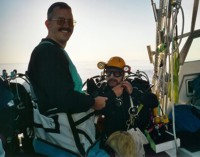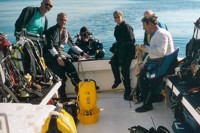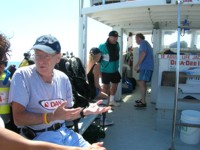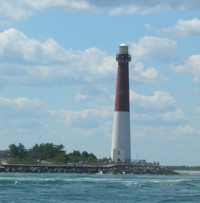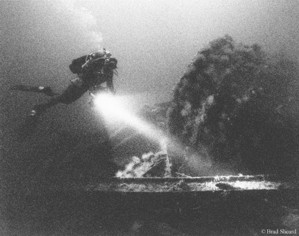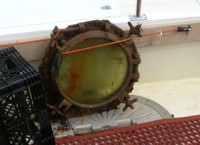Dive Report for the Dina Dee Nov 12 05
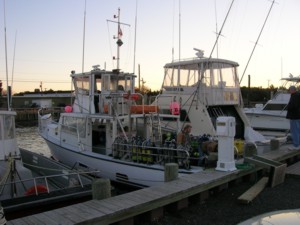 Synopsis: Cloudy surface, dark bottom 30ft vis with light. Trigger, Lobster, Winter Flounder, Tog, few Sea Bass, Artifacts, Temp 58.
Synopsis: Cloudy surface, dark bottom 30ft vis with light. Trigger, Lobster, Winter Flounder, Tog, few Sea Bass, Artifacts, Temp 58.
Details:
What a day! There was barely a cloud in the sky, bright sun, and 1-2 ft seas. What else could you ask for in November on the North Atlantic? We were all assembled on the deck of the Dina Dee II ( aka the Bottom Time II) for the first time since September. We discussed the pitiful weather that was October as we waited for one last no show. As the clock reached the hour, we got under way. Leaving the inlet the DM was giving us the standard brief. With one “novice” aboard, we headed to the San Saba. In 80 ft of water, it’s a nice wreck for easy navigation is often good for lobster.
Our “novice” had no computer, so he was asked if he could go by tables. The captain only had Navy dive tables aboard, and asked if he could read them. As it turns out, our “novice” just graduated for the US Navy dive school and was going into Navy salvage operations. OK, he was not a novice, and was quite adept with the navy dive tables.
Vis on the top was 10 at best. You had to be careful you did not run into someone on your hang. By the time we hit bottom, there was no light. I was out last week, and warned everyone, so we were prepared. The vis was a good 30 ft, and the beacon on the anchor could be seen from the other side of the boilers (50ft). The fish were all spooked by the lights, and hid within the wreck. You would occasionally see a large tog darting off into the distance. With lights in hand, we went looking for lobster. They where everywhere, some where even out of there holes. Most were small, only a few had eggs. I was surprised since most of the bugs we saw last week had eggs. It was a regular lobster maternity ward last week. After my buddy ran out of NDL time (air diver), I switched the light off and went looking for triggerfish. The hunt was in vain, alas I boarded the boat empty handed.
 |
|
Mmmmm Trigger! |
On the second dive we went looking for the bow of the wreck. Last dive we traversed the engines to the shaft and down to the prop. This time we headed out through the sand looking for the bow. Captain Roger had run a line so we were able to it with little issue. There was not much to see over there. Areas where I expected to see fish were vacant. I saw no lobster, and quickly ran into the NDL of my buddy. We headed back to the anchor, and I again went in search of trigger. Again the search was in vain.
One of our crew brought a DPV and went digging. He came up with a dozen jars. There was some discussion of jelly jars vs. olive jars … I do not know, but he gave everyone a few.
As it turns out only the captain came up with Trigger. I don’t know where he found them, but he says the were buried in the wreck not swimming about.
Well that’s the report. While there were not that many fish brought up, it was a great dive with good vis on a November afternoon. What a great day!!!
